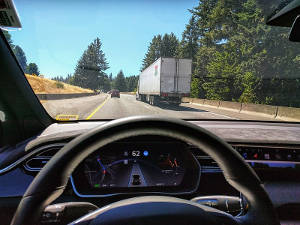The next revolution in transportation is expected to be shared autonomous vehicles, with personal cars yielding to driverless cars summoned on demand. For instance, Uber passengers in San Francisco, Pittsburgh and Phoenix can already hail driverless cars, and Bay Area Lyft riders will soon have the same opportunity.
This transportation revolution may seem like a positive development, but without careful planning, it could end up doing more harm than good.

Image credit: Ian Maddox (Source: Wikipedia)
It’s true that shared autonomous vehicles have the potential to make road travel faster, easier and cleaner. Yet, there are reasons to suspect that they could actually lead to heavier traffic, dirtier air and more greenhouse gas emissions. Transportation accounts for 27 percent of U.S. greenhouse gas emissions, so the environmental stakes are high. Now is the time to ensure that these shared autonomous vehicles contribute to a sustainable transportation future.
The benefits of these types of cars are numerous, and companies probably will adopt electric cars faster than individual owners will. Shared vehicles accumulate higher mileage, which amplifies the fuel cost savings from using electricity instead of gasoline.
As wind and solar generate growing shares of electricity, electrification of shared vehicle fleets would reduce greenhouse gas emissions significantly. Additionally, electric vehicles could facilitate wind and solar uptake by charging at times of abundant renewable electricity supply and low electricity demand, or by providing vehicle-to-grid battery storage.
Autonomous vehicles also achieve superior fuel economy by accelerating and braking more efficiently than human drivers can, and driverless cars can use sensors and communicate with nearby vehicles to travel at high speeds even in dense traffic. Each minute not spent in traffic or waiting at a red light means avoided energy consumption and emissions.
Carpooling services that allow passengers with similar routes to travel in the same vehicle have the potential to increase average occupancy and satisfy demand using fewer vehicle miles. But drivers have been lukewarm about UberPool.
On the contrary, shared autonomous vehicles might make people travel more. The value of time is a major cost of driving. Autonomous vehicle travel is effectively less costly than driving because driverless car passengers can work, eat, or do other activities while en route. According to the “rebound effect,” when the cost of an activity declines, demand for it increases.
It would therefore not be surprising if autonomous vehicles cause people to make longer and more numerous trips. The long-run travel increase could be severe if passengers tolerate longer commutes and opt to live in distant locales with cheaper housing. Additional miles require more energy use and associated emissions.
After an autonomous vehicle drops off a passenger, the fleet operator might reposition it to a location where new passengers arise more often, or where there is a dearth of available cars. These miles driven without passengers are termed “deadheading,” and a recent study that simulated shared autonomous vehicle operation concluded that it could add 10 percent more travel miles.
This all means that lawmakers in states and cities across the country should anticipate widespread adoption of these vehicles. They should enact policies to ensure that they contribute to — rather than impede — emission reduction efforts.
First, governments should regulate transportation to set ambitious emission standards for shared autonomous vehicle fleets. They are favorable markets for electric vehicles, and a stricter form of the Zero Emission Vehicle program implemented by California and nine other states could be applied to these vehicles.
Second, public transportation agencies should rethink their services so that shared autonomous vehicles complement public transportation rather than compete with it. In particular, these vehicles help solve the “last mile” problem and make not owning a car more feasible. Dallas Area Rapid Transit collaborates with Uber to provide door-to-door trips.
Third, land-use policies could counteract the rebound effect of shared autonomous vehicles on travel demand by inducing compact and mixed-use development. These urban forms reduce trip lengths and encourage walking and biking. Austin is currently redeveloping its land-use code with an eye toward more compact and connected communities.
The climate change impacts of shared autonomous vehicles are highly uncertain. But, by enacting appropriate policies now during their formative phase, we can make them an integral component of a sustainable transportation future.
By Benjamin D. Leibowicz, Assistant Professor of Mechanical Engineering
Benjamin D. Leibowicz is an assistant professor of mechanical engineering at The University of Texas at Austin.
*Source: The University of Texas at Austin
